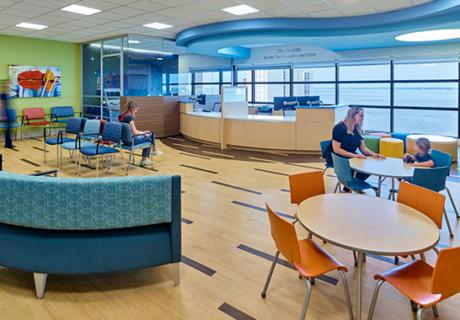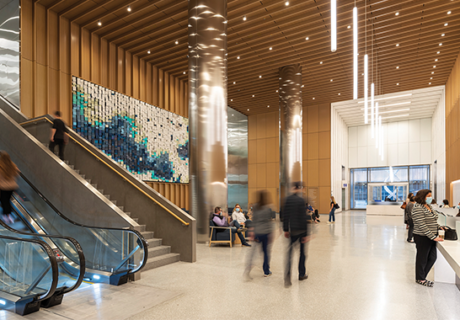Cincinnati Children’s Hospital Medical Center A5C Cancer Center; Blood Diseases Institute Inpatient Unit [Cincinnati]
Renovation cost per square foot: $410
Submitted by: GBBN Architects
For teenagers and young adults, cancer treatment is an especially high-stress experience. Their unique psychosocial needs are rarely catered to in patient environments, especially pediatric facilities geared toward young children. Engaging environments are necessary to prevent feelings of isolation and depression from prolonged hospital stays. This project remodeled an outpatient clinic space and elevator lobby located within an inpatient bed tower into a new Adolescent and Young Adult (AYA) inpatient unit. Additional amenities accessed from the elevator lobby serve two existing pediatric cancer units, creating welcoming, calming, and supportive spaces for patients and their families.
Through on-site observations, staff input and family/patient focus groups, we determined what set the needs of AYA patients apart: feeling empowered about their treatment, connected socially, and the ability to get out of the room whenever possible.
These patients often move into their rooms, bringing snacks, gaming systems, and treasured belongings that end up piled on windowsills and any available horizontal surface in the room. Because the patient room footprint was constrained to stacking with other rooms in the bedtower and the existing fenestration system, we used vertical space and mobile furniture to maximize space.
A zoning concept creates distinctive areas within the room analogous to a studio apartment. These “studios” include separate zones for sleeping, hanging out, storage, eating, and entertainment. Instead of the built in desk found on other units, we opted for a flip top table on wheels that could be moved out of the way to capture floor space, or brought bedside to enjoy an activity with friends or family. Charging stations for mobile devices and extra storage cabinets help to minimize clutter and give the gaming system a home.
To alleviate the stress and social disconnection that occurs with prolonged hospitalization, we extended the studio apartment idea and placed it within the context of a neighborhood. Inset entries to the “studios” create front porches with windows in the doors to provide connectivity to life on the “street”/corridors. Color blocking the studios into duplexes expressed through ceiling, floor, and wall treatments breaks the corridor into friendlier addresses than room numbers alone can provide, allowing patients to say, “I’m the second green room.” The unit also includes a series of destinations. The pocket lounges, workout room, laundry and holistic health spaces provide more intimate and impromptu space than a typical patient lounge, which AYA’s are averse to using. An activity room for group activities is visible from a corridor seating alcove so patients can transition their level of socialization.
At the heart of this remodel was the desire to provide choices and variety in surroundings that are familiar yet regenerative to allow AYA patients to assert control over even small decisions. The design highlights emotional well-being throughout the environment, incorporating psychosocial research with patient and staff feedback. The resulting design employs meaningful care spaces that focus on promoting the sense of coherence so crucial to patients who must endure long hospital stays.

![Cincinnati Children’s Hospital Medical Center A5C Cancer Center; Blood Diseases Institute Inpatient Unit [Cincinnati]](https://healthcaredesignmagazine.com/wp-content/uploads/2016/12/53a.jpg)
![Cincinnati Children’s Hospital Medical Center A5C Cancer Center; Blood Diseases Institute Inpatient Unit [Cincinnati]](https://healthcaredesignmagazine.com/wp-content/uploads/2016/12/53b.jpg)
![Cincinnati Children’s Hospital Medical Center A5C Cancer Center; Blood Diseases Institute Inpatient Unit [Cincinnati]](https://healthcaredesignmagazine.com/wp-content/uploads/2016/12/53c.jpg)
![Cincinnati Children’s Hospital Medical Center A5C Cancer Center; Blood Diseases Institute Inpatient Unit [Cincinnati]](https://healthcaredesignmagazine.com/wp-content/uploads/2016/12/53d.jpg)
![Cincinnati Children’s Hospital Medical Center A5C Cancer Center; Blood Diseases Institute Inpatient Unit [Cincinnati]](https://healthcaredesignmagazine.com/wp-content/uploads/2016/12/53e.jpg)
![Cincinnati Children’s Hospital Medical Center A5C Cancer Center; Blood Diseases Institute Inpatient Unit [Cincinnati]](https://healthcaredesignmagazine.com/wp-content/uploads/2016/12/53f.jpg)



